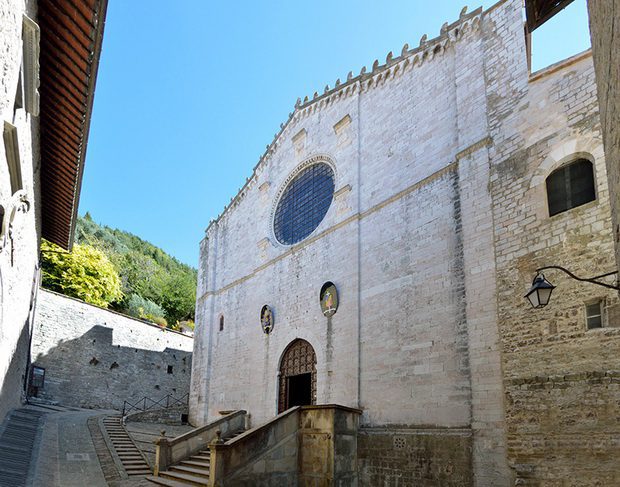La Cattedrale di Gubbio, conosciuta anche come Duomo di Gubbio o Basilica dei Santi Mariano e Giacomo Martiri, fu costruita negli ultimi vent’anni del XII secolo ed andò a sostituire una precedente chiesa già eretta nello stesso punto. Potete ancora trovare traccia di questo primo edificio sul lato destro della chiesa.
La cattedrale si presenta in pieno stile gotico: sopra il portale a sesto acuto c’è una magnifica e grande vetrata circolare, decorata da un’elegante fascia a fogliame. Ai lati della vetrata troviamo i simboli degli evangelisti: l’aquila di San Giovanni, il bue di San Luca, il leone di San Marco, l’angelo di San Matteo. Al centro del timpano si trova inoltre il simbolo di Giovanni Battista.
All’interno del Duomo di Gubbio
Altra vetrata che vi stupirà è quella presente nell’abside, alzando lo sguardo dall’interno ad unica navata potrete notare come sia caratterizzato da grandi arconi ogivali trasversi a sostegno del tetto. Lungo la parete destra sono visibili resti di affreschi trecenteschi, mentre appena accanto si trova l’Immacolata Concezione di Virgilio Nucci risalente al XVI secolo.
Lateralmente vi sono le piccole cappelle, al cui interno troviamo numerose le opere d’arte. La cappella del Santissimo Sacramento è stata eretta per volere del vescovo Alessandro Sperelli e fu decorata dal pittore eugubino Francesco Allegrini nel XVI secolo. I temi trattati dall’artista ricordano figure di santi legati alla storia cittadina, come Sant’Ubaldo, San Pier Damiani, San Rodolfo, San Giacomo e San Mariano. La tela con Nascita della Vergine è invece opera di Antonio Gherardi da Rieti (1684). Nella settima campata c’è la Pietà di Dono Doni, importante pittore assisiate.
La parete sinistra conserva, nella decima campata, un altare realizzato su sarcofago romano con sopra Sant’Ubaldo, con tela di Benedetto Nucci (XVI secolo) mentre nel coro si trova il Seggio episcopale, intagliato verso la metà del sec. XVI. Il sarcofago sotto l’altare maggiore contiene le reliquie dei SS. Giacomo e Mariano ai quali è intitolata la chiesa.
Di grande pregio è il Cristo ligneo sopra l’altare, che si presuppone essere di scuola umbra del XIII secolo.
>> Ci sono offerte in scadenza per agriturismi nella zona di Gubbio! Clicca e consultale subito
La Botte dei Canonici di Gubbio
Se volete ammirare altri importanti reperti e oggetti di culto, potete visitare l’annesso Museo della cattedrale. Attrazione piuttosto curiosa di questo museo è senz’altro la Botte dei Canonici, che si trova collocata proprio all’ingresso. Si tratta di una botte di dimensioni imponenti, capace di contenere fino a 200 ettolitri di vino; al suo interno venivano conservati ben 387 barili con una capienza di 52 litri ciascuno, il che equivaleva alla scorta dei canonici di Gubbio di un intero anno.
Oltre alle dimensioni davvero impressionanti, l’altra particolarità di questa botte è il fatto di essere interamente costituita da anelli in legno, senza l’ausilio del ferro né doghe metalliche, il che la rende un esemplare pressoché unico in Europa.
La botte è stata costruita dai monaci locali intorno al 1500 ed è stata utilizzata per conservare il vino fino al 1928 circa.
>>Se hai deciso di visitare Gubbio ti consigliamo di contattare ora i B&B nelle sue vicinanze



Comment (0)